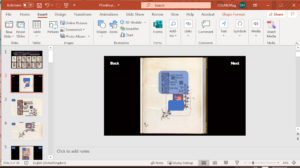1.5.5 Phoebe Anna Traquair’s Illuminated Manuscript

One of the questions posed to us at the January 17th meeting was from curator Olive Geddes, who asked “How does the Phoebe Anna Traquair manuscript fit in […] the overall theme of ‘advice’?” I would like to address that here.
In our meeting with NLS curators on October 4th, we were shown many hand-selected items from the collections which they thought may fit the theme of International Women’s Day, including Phoebe Anna Traquair’s illuminated manuscript of Elizabeth Barrett Browning’s Sonnets from the Portuguese. We had all been very taken with this piece, and thought it would make a perfect Big Ticket Item to attempt to draw visitors, considering her huge involvement in the Scottish Arts and Crafts movement.
Barrett Browning and Traquair were both women working in artistic fields which were, at the time, predominantly populated by men, and we have been considering them as providing Advice by Example. Barrett Browning in particular challenged the societal roles of women at the time by writing love poetry from a female perspective, showing the narrator as complex and emotionally-deep, a protest against popular love poetry of the time which strongly objectified women.
 This piece also fits the themes of digital display very well. It is a wonderful example of how the digital can work in tandem with the physical, rather than supersede it. I have created an interactive slideshow for touchscreen with 88 hot-spots, where visitors can explore and zoom on 12 additional pages of the manuscript. Having the physical book present beside this display will hopefully cause the viewer to appreciate the realness of the physical item, as well as to appreciate the magnificent craftsmanship through their ability to enlarge details.
This piece also fits the themes of digital display very well. It is a wonderful example of how the digital can work in tandem with the physical, rather than supersede it. I have created an interactive slideshow for touchscreen with 88 hot-spots, where visitors can explore and zoom on 12 additional pages of the manuscript. Having the physical book present beside this display will hopefully cause the viewer to appreciate the realness of the physical item, as well as to appreciate the magnificent craftsmanship through their ability to enlarge details.
Takeaways and For-Next-Times:
I wish we had included more about Elizabeth Barrett Browning, and her influence on early feminist movements, as well as on romantic literature.
Personally, I had a lot of fun researching the arguments we presented to Olive about why this book should be included, as well as creating the interactive programme.
As one of the Library’s most beautiful pieces, and one which rarely goes on display, I was surprised how hesitant multiple Library personnel were about allowing us to use it, and how hard we had to fight for its inclusion. This could indicate something about “old ways” of curation leaning towards safety and anti-risk, which has come up in some of our class discussions.
Entry Wordcount: 399
Running Total Wordcount: 3958




Recent comments